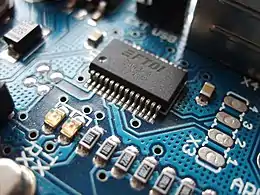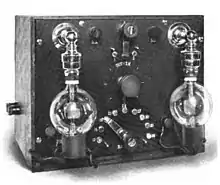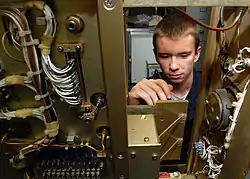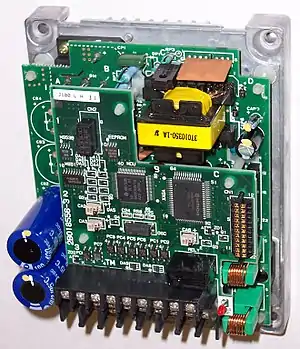Electronics
Electronics comprises the physics, engineering, technology and applications that deal with the emission, flow and control of electrons in vacuum and matter.[1] It uses active devices to control electron flow by amplification and rectification, which distinguishes it from classical electrical engineering which uses passive effects such as resistance, capacitance and inductance to control current flow.

Electronics has had a major effect on the development of modern society. The identification of the electron in 1897, along with the subsequent invention of the vacuum tube which could amplify and rectify small electrical signals, inaugurated the field of electronics and the electron age.[2] This distinction started around 1906 with the invention by Lee De Forest of the triode, which made electrical amplification of weak radio signals and audio signals possible with a non-mechanical device. Until 1950, this field was called "radio technology" because its principal application was the design and theory of radio transmitters, receivers, and vacuum tubes.
The term "solid-state electronics" emerged after the first working transistor was invented by William Shockley, Walter Houser Brattain and John Bardeen at Bell Labs in 1947. The MOSFET (MOS transistor) was later invented by Mohamed Atalla and Dawon Kahng at Bell Labs in 1959. The MOSFET was the first truly compact transistor that could be miniaturised and mass-produced for a wide range of uses, revolutionizing the electronics industry, and playing a central role in the microelectronics revolution and Digital Revolution. The MOSFET has since become the basic element in most modern electronic equipment, and is the most widely used electronic device in the world.
Electronics is widely used in information processing, telecommunication, and signal processing. The ability of electronic devices to act as switches makes digital information-processing possible. Interconnection technologies such as circuit boards, electronics packaging technology, and other varied forms of communication infrastructure complete circuit functionality and transform the mixed electronic components into a regular working system, called an electronic system; examples are computers or control systems. An electronic system may be a component of another engineered system or a standalone device. As of 2019 most electronic devices[3] use semiconductor components to perform electron control. Commonly, electronic devices contain circuitry consisting of active semiconductors supplemented with passive elements; such a circuit is described as an electronic circuit. Electronics deals with electrical circuits that involve active electrical components such as vacuum tubes, transistors, diodes, integrated circuits, optoelectronics, and sensors, associated passive electrical components, and interconnection technologies. The nonlinear behaviour of active components and their ability to control electron flows makes amplification of weak signals possible.
The study of semiconductor devices and related technology is considered a branch of solid-state physics, whereas the design and construction of electronic circuits to solve practical problems come under electronics engineering. This article focuses on engineering aspects of electronics.
Branches of electronics
Electronics has branches as follows:
Electronic devices and components


An electronic component is any physical entity in an electronic system used to affect the electrons or their associated fields in a manner consistent with the intended function of the electronic system. Components are generally intended to be connected together, usually by being soldered to a printed circuit board (PCB), to create an electronic circuit with a particular function (for example an amplifier, radio receiver, or oscillator). Components may be packaged singly, or in more complex groups as integrated circuits. Some common electronic components are capacitors, inductors, resistors, diodes, transistors, etc. Components are often categorized as active (e.g. transistors and thyristors) or passive (e.g. resistors, diodes, inductors and capacitors).[4]
History of electronic components
Vacuum tubes (Thermionic valves) were among the earliest electronic components.[5] They were almost solely responsible for the electronics revolution of the first half of the twentieth century.[6][7] They allowed for vastly more complicated systems and gave us radio, television, phonographs, radar, long-distance telephony and much more. They played a leading role in the field of microwave and high power transmission as well as television receivers until the middle of the 1980s.[8] Since that time, solid-state devices have all but completely taken over. Vacuum tubes are still used in some specialist applications such as high power RF amplifiers, cathode ray tubes, specialist audio equipment, guitar amplifiers and some microwave devices.
The first working point-contact transistor was invented by John Bardeen and Walter Houser Brattain at Bell Labs in 1947.[9] In April 1955, the IBM 608 was the first IBM product to use transistor circuits without any vacuum tubes and is believed to be the first all-transistorized calculator to be manufactured for the commercial market.[10][11] The 608 contained more than 3,000 germanium transistors. Thomas J. Watson Jr. ordered all future IBM products to use transistors in their design. From that time on transistors were almost exclusively used for computer logic and peripherals. However, early junction transistors were relatively bulky devices that were difficult to manufacture on a mass-production basis, which limited them to a number of specialised applications.[12]
The MOSFET (MOS transistor) was invented by Mohamed Atalla and Dawon Kahng at Bell Labs in 1959.[13][14][15][16] The MOSFET was the first truly compact transistor that could be miniaturised and mass-produced for a wide range of uses.[12] Its advantages include high scalability,[17] affordability,[18] low power consumption, and high density.[19] It revolutionized the electronics industry,[20][21] becoming the most widely used electronic device in the world.[15][22] The MOSFET is the basic element in most modern electronic equipment,[23][24] and has been central to the electronics revolution,[25] the microelectronics revolution,[26] and the Digital Revolution.[16][27][28] The MOSFET has thus been credited as the birth of modern electronics,[29][30] and possibly the most important invention in electronics.[31]
Types of circuits
Circuits and components can be divided into two groups: analog and digital. A particular device may consist of circuitry that has one or the other or a mix of the two types. An important electronic technique in both analog and digital electronics involves the use of feedback. Among many other things this allows very linear amplifiers to be made with high gain, and digital circuits such as registers, computers and oscillators.
Analog circuits

Most analog electronic appliances, such as radio receivers, are constructed from combinations of a few types of basic circuits. Analog circuits use a continuous range of voltage or current as opposed to discrete levels as in digital circuits.
The number of different analog circuits so far devised is huge, especially because a 'circuit' can be defined as anything from a single component, to systems containing thousands of components.
Analog circuits are sometimes called linear circuits although many non-linear effects are used in analog circuits such as mixers, modulators, etc. Good examples of analog circuits include vacuum tube and transistor amplifiers, operational amplifiers and oscillators.
One rarely finds modern circuits that are entirely analog. These days analog circuitry may use digital or even microprocessor techniques to improve performance. This type of circuit is usually called "mixed signal" rather than analog or digital.
Sometimes it may be difficult to differentiate between analog and digital circuits as they have elements of both linear and non-linear operation. An example is the comparator which takes in a continuous range of voltage but only outputs one of two levels as in a digital circuit. Similarly, an overdriven transistor amplifier can take on the characteristics of a controlled switch having essentially two levels of output. In fact, many digital circuits are actually implemented as variations of analog circuits similar to this example – after all, all aspects of the real physical world are essentially analog, so digital effects are only realized by constraining analog behavior.
Digital circuits
Digital circuits are electric circuits based on a number of discrete voltage levels. Digital circuits are the most common physical representation of Boolean algebra, and are the basis of all digital computers. To most engineers, the terms "digital circuit", "digital system" and "logic" are interchangeable in the context of digital circuits. Most digital circuits use a binary system with two voltage levels labeled "0" and "1". Often logic "0" will be a lower voltage and referred to as "Low" while logic "1" is referred to as "High". However, some systems use the reverse definition ("0" is "High") or are current based. Quite often the logic designer may reverse these definitions from one circuit to the next as he sees fit to facilitate his design. The definition of the levels as "0" or "1" is arbitrary.
Ternary (with three states) logic has been studied, and some prototype computers made.
Computers, electronic clocks, and programmable logic controllers (used to control industrial processes) are constructed of digital circuits. Digital signal processors are another example.
Building blocks:
- Metal-oxide-semiconductor field-effect transistor (MOSFET)
- Logic gates
- Adders
- Flip-flops
- Counters
- Registers
- Multiplexers
- Schmitt triggers
Highly integrated devices:
Heat dissipation and thermal management
Heat generated by electronic circuitry must be dissipated to prevent immediate failure and improve long term reliability. Heat dissipation is mostly achieved by passive conduction/convection. Means to achieve greater dissipation include heat sinks and fans for air cooling, and other forms of computer cooling such as water cooling. These techniques use convection, conduction, and radiation of heat energy.
Noise
Electronic noise is defined[32] as unwanted disturbances superposed on a useful signal that tend to obscure its information content. Noise is not the same as signal distortion caused by a circuit. Noise is associated with all electronic circuits. Noise may be electromagnetically or thermally generated, which can be decreased by lowering the operating temperature of the circuit. Other types of noise, such as shot noise cannot be removed as they are due to limitations in physical properties.
Electronics theory
Mathematical methods are integral to the study of electronics. To become proficient in electronics it is also necessary to become proficient in the mathematics of circuit analysis.
Circuit analysis is the study of methods of solving generally linear systems for unknown variables such as the voltage at a certain node or the current through a certain branch of a network. A common analytical tool for this is the SPICE circuit simulator.
Also important to electronics is the study and understanding of electromagnetic field theory.
Electronics lab
Due to the complex nature of electronics theory, laboratory experimentation is an important part of the development of electronic devices. These experiments are used to test or verify the engineer's design and detect errors. Historically, electronics labs have consisted of electronics devices and equipment located in a physical space, although in more recent years the trend has been towards electronics lab simulation software, such as CircuitLogix, Multisim, and PSpice.
Computer-aided Design (CAD)
Today's electronics engineers have the ability to design circuits using premanufactured building blocks such as power supplies, semiconductors (i.e. semiconductor devices, such as transistors), and integrated circuits. Electronic design automation software programs include schematic capture programs and printed circuit board design programs. Popular names in the EDA software world are NI Multisim, Cadence (ORCAD), EAGLE PCB and Schematic, Mentor (PADS PCB and LOGIC Schematic), Altium (Protel), LabCentre Electronics (Proteus), gEDA, KiCad and many others.
Packaging methods
Many different methods of connecting components have been used over the years. For instance, early electronics often used point to point wiring with components attached to wooden breadboards to construct circuits. Cordwood construction and wire wrap were other methods used. Most modern day electronics now use printed circuit boards made of materials such as FR4, or the cheaper (and less hard-wearing) Synthetic Resin Bonded Paper (SRBP, also known as Paxoline/Paxolin (trade marks) and FR2) – characterised by its brown colour. Health and environmental concerns associated with electronics assembly have gained increased attention in recent years, especially for products destined to the European Union, with its Restriction of Hazardous Substances Directive (RoHS) and Waste Electrical and Electronic Equipment Directive (WEEE), which went into force in July 2006.
Electronic systems design
Electronic systems design deals with the multi-disciplinary design issues of complex electronic devices and systems, such as mobile phones and computers. The subject covers a broad spectrum, from the design and development of an electronic system (new product development) to assuring its proper function, service life and disposal.[33] Electronic systems design is therefore the process of defining and developing complex electronic devices to satisfy specified requirements of the user.
Mounting Options
Electrical components are generally mounted in the following ways:
- Through-hole (sometimes referred to as 'Pin-Through-Hole')
- Surface Mount
- Chassis Mount
- Rack Mount
- LGA/BGA/PGA Socket
Electronics industry
The electronics industry consists of various sectors. The central driving force behind the entire electronics industry is the semiconductor industry sector,[34] which has annual sales of over $481 billion as of 2018.[35] The largest industry sector is e-commerce, which generated over $29 trillion in 2017.[36] The most widely manufactured electronic device is the metal-oxide-semiconductor field-effect transistor (MOSFET), with an estimated 13 sextillion MOSFETs having been manufactured between 1960 and 2018.[37] In the year 1960s, the U.S. manufacturers were unable compete with the Japanese companies like Sony and Hitachi as they produced quality product as well as the price of that product is better than the U.S manufacturers and as a result they found decline in consumer electronics industry. By the 1980s, however, U.S. manufacturers became the world leaders in semiconductor development and assembly.[38]
See also
References
- "electronics | Devices, Facts, & History". Encyclopedia Britannica. Retrieved 19 September 2018.
- "October 1897: The Discovery of the Electron". Retrieved 19 September 2018.
- Floyd, Thomas L. (2017). Electronics fundamentals : circuits, devices, and applications. ISBN 978-1-292-23880-7. OCLC 1016966297.
- Bose, Bimal K, ed. (1996). Power Electronics and Variable Frequency Drives: Technology and Applications. Wiley Online Library. doi:10.1002/9780470547113. ISBN 978-0-470-54711-3. S2CID 107126716.
- Guarnieri, M. (2012). "The age of vacuum tubes: Early devices and the rise of radio communications". IEEE Ind. Electron. M. 6 (1): 41–43. doi:10.1109/MIE.2012.2182822.
- Guarnieri, M. (2012). "The age of vacuum tubes: the conquest of analog communications". IEEE Ind. Electron. M. 6 (2): 52–54. doi:10.1109/MIE.2012.2193274.
- Guarnieri, M. (2012). "The age of Vacuum Tubes: Merging with Digital Computing". IEEE Ind. Electron. M. 6 (3): 52–55. doi:10.1109/MIE.2012.2207830.
- Sōgo Okamura (1994). History of Electron Tubes. IOS Press. p. 5. ISBN 978-90-5199-145-1. Archived from the original on 31 December 2013. Retrieved 5 December 2012.
- "1947: Invention of the Point-Contact Transistor". Computer History Museum. Retrieved 10 August 2019.
- Bashe, Charles J.; et al. (1986). IBM's Early Computers. MIT. p. 386.
- Pugh, Emerson W.; Johnson, Lyle R.; Palmer, John H. (1991). IBM's 360 and early 370 systems. MIT Press. p. 34. ISBN 978-0-262-16123-7.
- Moskowitz, Sanford L. (2016). Advanced Materials Innovation: Managing Global Technology in the 21st century. John Wiley & Sons. p. 168. ISBN 978-0-470-50892-3.
- "1960 – Metal Oxide Semiconductor (MOS) Transistor Demonstrated". The Silicon Engine. Computer History Museum.
- Lojek, Bo (2007). History of Semiconductor Engineering. Springer Science & Business Media. pp. 321–3. ISBN 978-3-540-34258-8.
- "Who Invented the Transistor?". Computer History Museum. 4 December 2013. Retrieved 20 July 2019.
- "Triumph of the MOS Transistor". YouTube. Computer History Museum. 6 August 2010. Retrieved 21 July 2019.
- Motoyoshi, M. (2009). "Through-Silicon Via (TSV)". Proceedings of the IEEE. 97 (1): 43–48. doi:10.1109/JPROC.2008.2007462. ISSN 0018-9219. S2CID 29105721.
- "Tortoise of Transistors Wins the Race – CHM Revolution". Computer History Museum. Retrieved 22 July 2019.
- "Transistors Keep Moore's Law Alive". EETimes. 12 December 2018. Retrieved 18 July 2019.
- Chan, Yi-Jen (1992). Studies of InAIAs/InGaAs and GaInP/GaAs heterostructure FET's for high speed applications. University of Michigan. p. 1.
The Si MOSFET has revolutionized the electronics industry and as a result impacts our daily lives in almost every conceivable way.
- Grant, Duncan Andrew; Gowar, John (1989). Power MOSFETS: theory and applications. Wiley. p. 1. ISBN 978-0-471-82867-9.
The metal-oxide-semiconductor field-effect transistor (MOSFET) is the most commonly used active device in the very large-scale integration of digital integrated circuits (VLSI). During the 1970s these components revolutionized electronic signal processing, control systems and computers.
- Golio, Mike; Golio, Janet (2018). RF and Microwave Passive and Active Technologies. CRC Press. pp. 18–2. ISBN 978-1-4200-0672-8.
- Daniels, Lee A. (28 May 1992). "Dr. Dawon Kahng, 61, Inventor In Field of Solid-State Electronics". The New York Times. Retrieved 1 April 2017.
- Colinge, Jean-Pierre; Greer, James C. (2016). Nanowire Transistors: Physics of Devices and Materials in One Dimension. Cambridge University Press. p. 2. ISBN 978-1-107-05240-6.
- Williams, J. B. (2017). The Electronics Revolution: Inventing the Future. Springer. p. 75. ISBN 978-3-319-49088-5.
Though these devices were not of great interest at the time, it was to be these Metal Oxide Semiconductor MOS devices that were going to have enormous impact in the future
- Zimbovskaya, Natalya A. (2013). Transport Properties of Molecular Junctions. Springer. p. 231. ISBN 978-1-4614-8011-2.
- Raymer, Michael G. (2009). The Silicon Web: Physics for the Internet Age. CRC Press. p. 365. ISBN 978-1-4398-0312-7.
- Wong, Kit Po (2009). Electrical Engineering – Volume II. EOLSS Publications. p. 7. ISBN 978-1-905839-78-0.
- Kubozono, Yoshihiro; He, Xuexia; Hamao, Shino; Uesugi, Eri; Shimo, Yuma; Mikami, Takahiro; Goto, Hidenori; Kambe, Takashi (2015). "Application of Organic Semiconductors toward Transistors". Nanodevices for Photonics and Electronics: Advances and Applications. CRC Press. p. 355. ISBN 978-981-4613-75-0.
- Cerofolini, Gianfranco (2009). Nanoscale Devices: Fabrication, Functionalization, and Accessibility from the Macroscopic World. Springer Science & Business Media. p. 9. ISBN 978-3-540-92732-7.
- Thompson, S. E.; Chau, R. S.; Ghani, T.; Mistry, K.; Tyagi, S.; Bohr, M. T. (2005). "In search of "Forever," continued transistor scaling one new material at a time". IEEE Transactions on Semiconductor Manufacturing. 18 (1): 26–36. doi:10.1109/TSM.2004.841816. ISSN 0894-6507.
In the field of electronics, the planar Si metal–oxide–semiconductor field-effect transistor (MOSFET) is perhaps the most important invention.
- IEEE Dictionary of Electrical and Electronics Terms ISBN 978-0-471-42806-0
- J. Lienig; H. Bruemmer (2017). Fundamentals of Electronic Systems Design. Springer International Publishing. p. 1. doi:10.1007/978-3-319-55840-0. ISBN 978-3-319-55839-4.
- "Annual Semiconductor Sales Increase 21.6 Percent, Top $400 Billion for First Time". Semiconductor Industry Association. 5 February 2018. Retrieved 11 October 2019.
- "Semiconductors – the Next Wave" (PDF). Deloitte. April 2019. Retrieved 11 October 2019.
- "Global e-Commerce sales surged to $29 trillion". United Nations Conference on Trade and Development. 29 March 2019. Retrieved 13 October 2019.
- "13 Sextillion & Counting: The Long & Winding Road to the Most Frequently Manufactured Human Artifact in History". Computer History Museum. 2 April 2018. Retrieved 28 July 2019.
- "Consumer electronics industry in the year 1960s". NaTechnology. Retrieved 2 February 2021.
Further reading
- The Art of Electronics ISBN 978-0-521-37095-0
External links
| Wikibooks has more on the topic of: Electronics |
| Wikibooks has a book on the topic of: Electrical_engineering |
| Wikisource has original text related to this article: |
| Wikiversity has learning resources about School:Electronics |
| Wikimedia Commons has media related to Electronics. |
- Electronics at Curlie
- http://www.dictionary.com/browse/electronics
- Navy 1998 Navy Electricity and Electronics Training Series (NEETS)
- DOE 1998 Electrical Science, Fundamentals Handbook, 4 vols.
